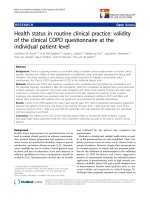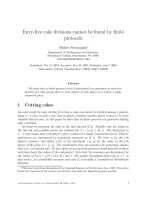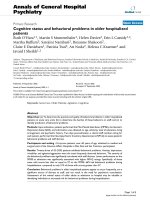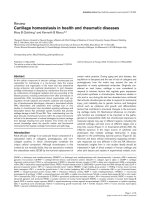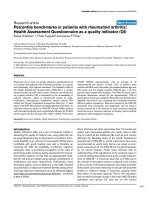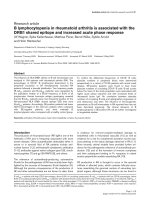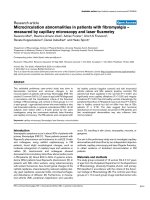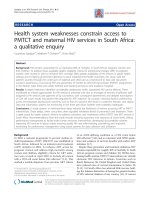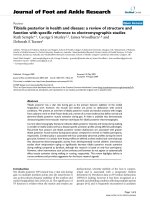Báo cáo y học: "Health status in COPD cannot be measured by the St George’s Respiratory Questionnaire alone: an evaluation of the underlying concepts of this questionnaire" ppt
Bạn đang xem bản rút gọn của tài liệu. Xem và tải ngay bản đầy đủ của tài liệu tại đây (224.73 KB, 7 trang )
RESEARC H Open Access
Health status in COPD cannot be measured by
the St George’s Respiratory Questionnaire alone:
an evaluation of the underlying concepts of this
questionnaire
Leonie Daudey
1,2*
, Jeannette B Peters
1,2
, Johan Molema
2
, PN Richard Dekhuijzen
2
, Judith B Prins
1
,
Yvonne F Heijdra
2
, Jan H Vercoulen
1,2
Abstract
Background: Improving patients’ health status is one of the major goals in COPD treatment. Questionnaires could
facilitate the guidance of patient-tailored disease management by exploring which aspects of health status are
problematic, and which aspects are not. Health status consists of four main domains (physiological functioning,
symptoms, functional impai rment, and quality of life), and at least sixteen sub-domains. A prerequisite for patient-
tailored treatment is a detailed assessment of all these sub-domains. Most questionnaires developed to measure
health status consist of one or a few subscales and measure merely some aspects of health status. The question
then rises which aspects of health status are measured by these instruments, and which aspects are not covered.
As it is one of the most frequently used questionnaires in COPD, we evaluated which aspects of health status are
measured and which aspects are not measured by the St George’s Respiratory Questionnaire (SGRQ).
Methods: One hundred and forty-six outpatients with COPD participated. Correlations were calculated between
the three sections of the SGRQ and ten sub-domains of the Nijmegen Integral Assessment Framework, covering
Symptoms, Functional Impairment, and Quality of Life. As the SGRQ was not expected to measure physiological
functioning, we did not include this main domain in the statistical analyses. Pearson’sr≥ 0.70 was used as criterion
for conceptual similarity.
Results: The SGRQ sections Symptoms and Tota l showed conceptual similarity with the sub-domain Subjective
Symptoms (main domain Symptoms). The sections Activity, Impacts and Total were conceptual similar to Subjective
Impairment (main domain Functional Impairment). The SGRQ sections were not conceptual similar to other sub-
domains of Symptoms, Functional Impairment, nor to any sub-domain of Quality of Life.
Conclusions: The SGRQ could facilitate the guidance of disease management in COPD only partially. The SGRQ is
appropriately only for measuring problems in the sub-domains Subjective Symptoms and Subjective Impairment,
and not for measuring problems in other sub-domains of health status, such as Quality of Life.
Background
COPD is a chronic and debilitating disease and a lead-
ing cause of morbidity and mortality worldwide [1].
According to the latest estimates of the World Health
Organization (WHO), 210 million people have COPD
and 3 million people died of COPD in 2005 [2].
Improving patients’ health status is one of the major
goals in COPD treatment [3].
Quality of life has become an important endpoint in
medical care, but still there is no consensus on the defi-
nition of these concepts [4]. Smith and colleagues con-
sider quality of life and health status to be separate
constructs, in which quality of life is more related to
mental health, whereas health status is more related to
physical functioning [4]. The WHO uses a broader
* Correspondence:
1
Department of Medical Psychology, Radboud University Nijmegen Medical
Centre, Nijmegen, the Netherlands
Daudey et al. Respiratory Research 2010, 11:98
/>© 2010 Daudey et al; licensee BioMed Central Ltd. This is an Open Access article distributed under the terms of the Creative Commons
Attribution License (http://creativecom mons.org/licenses/by/2.0), which permits unrestricted use, distribution, and reproduction in
any medium , provided the original work is properly cited.
definition of health status, by defining health status as ‘a
state of complete physical, mental and social well-being,
and not merely the absence of disease o r infirmity’ .
Similarly, others [5, 6] definehealthstatusasanoverall
concept covering physiological functioning, symptoms,
functional impairment, quality of life, and social func-
tioning as important main domains. These main
domains were empirically found to be further divided
into sixteen sub-domains [7,8], each sub-domain repre-
senting a unique aspect of health status. Despite differ-
ences in definitions found in the literature it has
become clear that a patient’s functioning consists of
many conceptually distinct sub-domains. Patient-tailored
treatment then requires assessment of all these sub-
domains.
Questionnaires could facilitate the guidance of patient-
tailored disease management by explo ring which aspects
of health status are proble matic and which aspects are
not. The past decade many questionnaires have been
developed to measure health status. However, most of
these instruments consists of only one o r a few sub-
scales and thus measure merely some aspects of health
status. The question then rises which aspects of health
status are measured by these instruments, and which
aspects are not covered.
The St George’s Respiratory Questionnaire (SGRQ),
for instance, is one of the most freque ntly used and
translated disease specific health status instruments in
COPD [9-11]. A recent Pubmed search gave 555 hits
(date 06/03/2010; terms SGRQ and St George’s Respira-
tory Questionnaire). The SGRQ has been developed to
allow comparative measurement of health between
patient populations and to quantify changes in health
following therapy [12]. The SGRQ consists of three sec-
tions and a total score: Symptoms, measuring the fre-
quency and severity of respiratory symptoms; Activity,
measuring limitation of activities by breathlessness and
activities that cause breathlessness; Impacts, measuring
disturbances in social and psychological functioning due
to airway disease; Total score summarizes the impact of
the disease on overall health status [12-14]. The SGRQ
thus measures maximall y three of the sixteen aspects of
health status. It is not clear which aspects of health sta-
tus are measured, and which aspects of health status are
notmeasuredbytheSGRQ.Thisquestionisallthe
important to unravel, because the SGRQ, as many other
questionnaires, is subject to conceptual confusion. The
SGRQ initially was conceived as a standardized self-
completed questionnaire for measuring health and per-
ceived well-being (’QoL’) in airways diseases [12]. In the
literature, however, the SGRQ is interchangeably
referred to as a measure of quality of life [15], health-
related quality of life [16], health status [17], a measure
for impaired health [18], or a measure of overall impact
of the disease [19]. Different terms are used for the con-
cept(s) the SGRQ measures. Additionall y, since the
SGRQ is often used as a criterion in validity testing of
other instruments [20,21], it is essential to clarify which
aspects of health status the SGRQ measures.
In the present study, we tested which aspects of health
status are measured by the SGRQ in COPD, by compar-
ing the SGRQ sections Symptoms, Activity and Impacts
with multiple aspects of the health status domains
Symptoms, Functional Impairment and Quality of Life.
Material and methods
Subjects
The 146 subjects took part o n a longitudinal study on
health status in COPD. Patients were recruited from
three different outpatient centres in the Netherlands:
Radboud University Nijmegen Medical Centre, Maas
Hospital Boxmeer, and Rijnstate Hospital Arnhem.
Patients had to fulfil the Global Initiative for Chronic
Obstructive Lung Disease (GOLD) criteria of a post-
bronchodilator FEV
1
% predicted between 30 and 80 per-
cent with a reversibility of obstruction of less than 12%
[1]. Pati ents suffering from primary co-morbidity or co-
morbidity that prevented full adherence to the research
protocol were excluded, a s well as patients with an
acute exacerbation, recent (<6 months) participation in
a rehabilitation program, or who w ere not able to speak
or read Dutch. One-hundred-and-sixty-eight patients
participated in this study. After one year, the assess-
ments were repeated in 146 patients (87% of included
patients in first part). Reasons for dropout were diverse:
passed away (N = 5), co-morbidity (N = 3), participation
in a rehabilitation programme between the first and sec-
ond assessments (N = 2), being too busy (N = 4), found
participation too exhausting (N = 3), or no transporta-
tion (N = 2). For three patients the reasons for dropout
were unknown. Data of these 146 patients were used in
the present study. The inclusion procedure is described
in more detail elsewhere [7]. The study was approved by
the Medical Ethics Committee CMO Region Arnhem-
Nijmegen (P02.1411L; CMO-nr 2002/047). Subjects gave
informed consent.
Procedures
Subjects visited the Department of Pulmonary Diseases
twice. Physiological assessments were performed and
subjects received the Aktometer (accelerometer measur-
ing actual physical activity) [22 ]. Two weeks later sub-
jects completed questionnai res by the T estOrg ani ser, a
computer program developed by the Department of
Medical Psychology and the Department of Instrumental
Services of the Radboud University Nijmegen Medical
Centre [7]. Questionnaires were presented in t he same
layout as the paper-and-pencil versions, and a simple
Daudey et al. Respiratory Research 2010, 11:98
/>Page 2 of 7
response board enabled subjects with no prior computer
experience to operate the TestOrganiser easily.
Measurements
Demographic data were recorded. Pulmonary function
tests were performed, including transfer capacity for car-
bon monoxide using the Jaeger masterlab-spirometer
according to ERS-crit eria [23], and indices of body com-
position (BodyStat 1997).
St George’s Respiratory Questionnaire (SGRQ)
The SGRQ consists of 50 items with weighted responses
divided in three sections - Symptoms, Activity,and
Impacts -andaTotal score [12-14]. Scores are
expressed as percentages of the maximally possible sum
of weights. A score of zero represent s no health impair-
ment, a score of 100 means maximal health impairment.
Health status main domains Symptoms, Functional
Impairment, and Quality of Life
Health status was measured by the Nijmegen Integral
Assessment Framework (NIAF) [7]. The NIAF provides
a detailed and empirical definition of health status and
covers the domains Physiological Functioning, Symp-
toms, Functional Impairment, and Quality of Life. These
four main domains were found to be subdivided into 15
distinct sub-domains [7]. In another study [8], we fo und
that fatigue was an additional sub-domain. Factor ana-
lyses were used to identify u nderlying concepts in the
data. Social Functioning did not emerge as a separate
factor, aspects of social functioning were part of the
main domains Quality of Life and Functional Impair-
ment. The sub-domains are measured by different exist-
ing instruments, and for each sub-domain a Sub-domain
Total Score (STS) wa s calculated. As the SGRQ was not
expected to measure physiological functioning, in this
studyweonlyevaluatedthetensub-domainsofthe
main domains Symptoms, Functional Impairment, and
Quality of Life. See Table 1 for definitions of the sub-
domains and corresponding instruments.
Statistical Analyses
The relationships between the sections of the SGRQ and
the sub-domains of the NIAF, as well as the intercorrela-
tions of the SGRQ sections, were analyzed by Pearson cor-
relation coefficients. To avoid Type I error due to multiple
testing P was set at 0.01. A Pearson’sr≥ 0.70 was used as
criterion for conceptual similarity between the sections of
the SGRQ and the sub-domains of the NIAF [24].
Results
Subjects
The study sample could be characterized as predomi-
nantly male, low educated, and living with a partner
(Table 2). Most subjects were GOLD II/III patients.
Some subjects were classified in GOLD I o r IV, due to
normal variation in FEV
1
between the time of t he first
assessment and second assessment one year later.
Conceptual similarity between sections of the SGRQ and
sub-domains of the NIAF
The SGRQ secti ons were significan tly correlated to
many health status aspects, however concep tual similar-
ity (r ≥ 0.70) was only reached for two sub-domains of
theNIAF(Table3).TheSGRQsectionsSymptoms and
Total were conceptual similar to the NIAF sub-domain
Subjective Symptoms (main domain Symptoms). The
SGRQ sections Activit y, Impacts,andTotal were con-
ceptually similar to the NIAF sub-domain Subjective
Impairment (main domain Functional Impairment).
Intercorrelations of the SGRQ sections
Intercorrelations between the SGRQ sections were mod-
erate to high (Table 4). The SGRQ section Total
exceeded the criterion of conc eptual similarity with all
SGRQ sections (r ≥ 0.70, p < 0.01). The correlation
between the sections Impacts and Activity almost
reached the criterion of conceptual similarity (r = 0.69,
p < 0.01).
Discussion
The present study evaluated which aspects of health sta-
tus are measured by the sections of the SGRQ, and
which aspects of health status are not covered by the
SGRQ.
The sections of the SGRQ correlated significantly with
most sub-domains of the NIAF, indicating that the
SGRQ was related to ma ny health status aspects. How-
ever, most correlations were low to moderate and well
below 0.70, indicating that shared variance was too low
to conclude that sections of the SGRQ were concep-
tually similar to these sub-domains.
Applying the criterion of conceptual similarity , the
SGRQ measured two of the ten evaluated sub-domains
of health status. The SGRQ sections Symptoms and
Total showed conceptual similarity with the sub-domain
Subjective Symptoms (main d omain Symptoms), the
SGRQ sections Activity, Impacts, and Total showed con-
ceptual similarity with the sub-domain Subjective
Impairment (main domain Functional Impairment).
In a previous study [7] we found a high correlation
between the sub-domains Subjective Impairment and
Subjective Symptoms. The instruments included in
these sub-domains were different with respect to the
content of the items, but had in common that the item-
and-response format required highly subjective and gen-
eral interpretations by the patient. It was argued that
both sub-domains measured highly subjective notions of
Daudey et al. Respiratory Research 2010, 11:98
/>Page 3 of 7
‘being ill’, also referred to as illness perceptions [25]. As
the SGRQ reached the criterion for conceptual similarity
with these two sub-domains, this would imply that the
SGRQ in fact measures illness perceptions, related to
symptoms (section Symptoms and Total) and functional
impairment (sections Activity and Impacts). This conclu-
sion is underlined by the high intercorrelatio ns between
the SGRQ sections, some correlations even exceeding
the criterion for conceptual similarity.
Although illness perceptions related to symptoms
and functional impairment are very relevant concepts,
many other important aspects of health status are not
covered by the SGRQ. With respect to the SGRQ as a
measure of aspects of symptoms, these are restricted
to the subjectively experienced severity of pulmonary
symptoms. Other important aspects of symptoms, such
as dyspnea-related emotions, are not measured specifi-
cally. With respect to functional impairment, only the
subjectively experienced impairments are measured by
the SGRQ. Impairment on the behavioural level or
actual physical activity level is not measured by the
SGRQ sections. Furthermore, the present study showed
that the SGRQ does not measure any of the three sub-
domains of q uality of life e valuated in this study (Gen-
eral Quality of Life, Health-related Quality of Life, and
Satisfaction Relation). Finally, since the SGRQ mea-
sures merely two sub-domains of the ten evaluated
sub-domains, the SGRQ does not provide a detailed
measurement of health status. Similarly, present data
show that the SGRQ should be considered a valid
measure of impaired health in COPD, as the SGRQ
originally was conceived. However, the SGRQ mea-
sures only two aspects of impaired health (subjective
symptoms and subjective impairment). To measure all
aspects of impaired health, and thereby allowing
patient-tailored treat ment, other instruments need to
be included as well.
Some methodological issues need to be addressed.
First,theNIAFisnotthedefiniteanswertothepro-
blem of conceptual confusion in current health status
instruments. Other aspects of health status not included
in the framework may be relevant to COPD patients.
This needs to be addressed in future studies, in which
patient feedback should be incorporated. Nevertheless,
this framework does provide a much more deta iled defi-
nition of health status, as expressed by the many sub-
domains, and is much more formulated in terms of
empirical observations than found in the literature. Each
sub-domain represents a (conceptually) unique health
status aspect. At least 16 sub-domains are measured to
Table 1 Main domains Symptoms, Functional Impairment and Quality of Life of the Nijmegen Integral Assessment
Framework
Sub-domain Definition Instrument (subscales)
Symptoms
Subjective
Symptoms
The patient’s overall burden of pulmonary
symptoms
PARS-D: Global Dyspnea Activity, Global Dyspnea Burden, Dyspnea
Activity [7]; QoLRiQ: Breathing Problems [33]
Dyspnea
Emotions
The level of frustration, depressive feelings, and
anxiety a person
experiences when dyspnoeic
DEQ: Frustration, Mood, Anxiety [7]
Expected
Dyspnea
The level of dyspnea that a patients expect to
experience during specific
activities no longer performed
PARS-D: Expected Dyspnea [7]
Fatigue The level of experienced fatigue CIS: Subjective fatigue [34]
Functional
Impairment
Actual Physical
Activity
The actual physical activity a patient performs
during two weeks
Aktometer (electronic accelerometer) [22]
Behavioral
Impairment
The extent to which a person cannot perform
specific and concrete
activities as a result of having the disease
SIP: Body Care & Movement, Home Management, Mobility, Ambulation
[35]
Subjective
Impairment
The experienced degree of impairment in
general, and in social functioning
QoLRiQ: General Activities, Social Activities [33]; Global Impairment [7];
SIP: Social Interaction, Burden [35]
Quality of Life
General Quality
of Life
Mood, anxiety, and the satisfaction of a person
with his/her life as a whole
Satisfaction With Life Scale [36] Symptom Check List: Anxiety [37]
BDI: Primary Care [38]
Health-related
Quality of Life
Satisfaction related to physiological functioning
and the future
Satisfaction Physiological Functioning, Satisfaction Future [7]
Satisfaction
Relations
Satisfaction with the (absent) relationships with
spouse and others
Satisfaction Spouse, Satisfaction Social [7]
PARS-D: Physical Activity Rating Scale-Dyspnea; QoLRiQ: Quality of Life for Respiratory Illness Questionnaire; DEQ: Dyspnea Emotions Questionnaire; CIS: Checklist
Individual Strength; SIP: Sickness Impact Profile; BDI, Beck Depression Inventory
Daudey et al. Respiratory Research 2010, 11:98
/>Page 4 of 7
provide a detailed picture of the health status of a
COPD patient.
Second, using the criterion of conceptual similarity (r
≥ 0.70) as a standard for validity seems a very strict cri-
terion. However, considering the conceptual confusion
in health status, one must be carefully interpreting
results of earlier validity studies. Often, much lower cor-
relations are accepted as evidence for the validity of the
instrument under scrutiny. For example, a correlation
between two instruments of 0.40 may be statistically sig-
nificant, but it indicates only 16% of shared variance.
Unambiguous conclusions con cerning conceptual simi-
larity between two instruments can onl y be drawn from
the results using a strict approach.
Thepresentstudyfocusesontherelationships
between the SGRQ sections and the main domains
Symptoms, Functional Impairm ent, and Qualit y of L ife.
Therefore, the conclusions of the present study are not
applicable with respect to physiological functioning.
However, from a theoretical point of view it is unlikely
that a questionnaire will provide a direct measure of
physiological processes. For example, studies to date
[26,27] often show a relationship between FEV
1
and the
SGRQ. However, these correlations are low to moderate
and do not exceed the criterion of conceptual similarity.
With respect to generalizability of the present study,
webelievethatthepresentsamplemaybeanadequate
reflection of a the Dutch population of patients with
COPD seen in an outpatient clinic. This sample may
however not be representative for subgroups of COPD
such as patients in pulmonary rehabilitation or patients
with primary co-morbidity, which were two major
exclusion criteria.
An important clinical implication of the present study
is that the SGRQ could facilitate the guidance of disease
management only partially. The SGRQ can only be used
appropriately for exploring problems in the sub-domains
Subjective Symptoms and Subjective Impairment, and
not for exploring problems in other sub-domains of
health status, such as aspects of quality of life.
Most instruments claiming to measure specific aspects
of health status contain only two to five subscales. Thus,
at best only some aspects of health status are measured
by a specific instrument. This not only has implications
for clinical practice, but also for re search purposes. In
pharmacological trials, the drug under study may have
beneficial effects on some aspects of health status, but
not on o ther aspects. If the instruments used measure
only few aspects of health status beneficial effects may
be missed. With respect to the use of instruments in
clinical practice, the present results indicate that one
single instrument cannot provide sufficient information
on a patient’s health status to effectively tailor treatment
to the needs of the individual patient, since measuring
all aspects of health status is a prerequisite for patient-
tailored treatment. This requires combining different
instruments into a battery of instruments measuring
multiple aspects of health status. However, implement-
ing instruments in daily practice to facilitate disease
management requires that instruments are not too time
consuming. The past decade a few short instruments
have been developed specifically to allow measurement
of health status aspects in routine care, such as the
Table 2 Demographic, clinical data, and data of the St
George’s Respiratory Questionnaire of participating
COPD patients
Variable Mean ± SD
Male sex % 76.7
Age (years) 65.8 ± 9.0
Education %
Low 48.6
Middle 29.5
High 19.9
Personal situation %
Partner 77.8
Divorced 6.3
Widowhood 8.3
Single 7.6
Cigarette smoking %
Current 41.8
Former 45.9
Never 11.0
BMI (kg/m
2
) 25.9 ± 4.1
FEV
1
(L) 1.6 ± 0.5
FEV
1
% predicted 53.6 ± 13.9
FEV
1
/FVC % 44.0 ± 11.4
TLC % predicted 103.7 ± 14.6
RV % predicted 128.3 ± 30.3
TL
CO
% predicted 62.3 ± 21.5
GOLD %
I 2.1
II 58.9
III 34.2
IV 4.8
SGRQ section
Symptoms 40.9 ± 24.8
Activity 40.9 ± 21.8
Impacts 20.2 ± 13.5
Total 30.2 ± 15.4
Data are presented as mean ± SD unless otherwise indicated. Percentages
may not add up to 100 due to missing data (three patients with no specified
education, two patients with no specified smoking habits). BMI: body mass
index; FEV
1
% predicted: forced expiratory volume in one second as
percentage predicted; FEV
1
/FVC %: forced expiratory volume/forced vital
capacity; TLC: total lung capacity; TLC % predicted: total lung capacity as
percentage predicted; RV: residual volume; RV: residual volume as percentage
predicted; TL
CO
% predicted: transfer capacity (of lung) for carbon monoxide
as percentage predicted; GOLD: Global Initiative for Chronic Obstructive Lung
Disease; SGRQ: St George’s Respiratory Questionnaire.
Daudey et al. Respiratory Research 2010, 11:98
/>Page 5 of 7
Clinical COPD Questionnaire [28], the Respiratory Ill-
ness Questionnaire-monitoring 10 [29], and the Euro-
QoL [30]. None of these instruments provide a detailed
picture of a patient’s health status. Recently, we devel-
oped the Nijmegen Clinical Screening Instrument
(NCSI), an instrument which can be used in routine
care [31]. The NCSI is based on the NIAF and measures
eleven sub-domains of physiological functioning, symp-
toms, functional impairment, and quality of life. The
NCSI enables a quick (15-25 minutes) and detailed
assessment of health status. Also, the COPD Assessment
Test (CAT) was developed [32], ‘ a vali dated short
and simple instrument for assessing the impact of
COPD on health status’ .TheCATisconstructedasa
uni-dimensional instrument, i.e. measuring one single
concept, as expressed in a single score. In addition, the
correl ation between the CAT and the SGRQ-C was well
above the criterion for conceptual similarity (r = 0.80)
[32]. Taken together, it is very likely that the CAT, like
the SGRQ, measures illness perceptions. How important
illness perceptions may be, patient-tailored treatment
require s a detailed assessment of many aspects of health
status. Therefore, the CAT also will h ave limited value
in patient-tailored treatment.
Conclusions
Detailed measurement of health status in patients with
COPD is a prerequisite for patient-tailored treatment.
However, carefulness should be noted when selecting
instruments to measure health status, because most
instruments measure only a few aspects of health status.
The SGRQ can only be used appropri ately for measuring
problems in the sub-domains Subjective Symptoms and
Subjective Impairment, and not for measuring problems
in other sub-domains of health status, such as as pects of
Quality of Life. Different instruments should be combined
to provide a detailed picture of a patient’s health status.
Acknowledgements
We are indebted to Dr. F. van den Elshout (pulmonologist, Rijnstate Hospital,
Arnhem) and Dr. R. Bunnik (pulmonologist, Maas Hospital, Boxmeer) for their
contribution in the patient recruitment and the multidisciplinary Taskforce
Assessment of the Department of Pulmonary Rehabilitation for their
invaluable contributions to the development of the conceptual models.
The study was supported by grants of the Dutch Asthma Foundation and
GlaxoSmithKline.
Author details
1
Department of Medical Psychology, Radboud University Nijmegen Medical
Centre, Nijmegen, the Netherlands.
2
Department of Pulmonary Diseases,
Radboud University Nijmegen Medical Centre, Groesbeek, the Netherlands.
Authors’ contributions
LD participated in the design of the study, the acquisition of the data,
performed statistical analyses and interpreted the data, and drafted the
manuscript. JBPe participated in the acquisition of the data, and in the
critical revision of the manuscript for important intellectual content. JM
participated in the design of the study, the acquisition of the data, and in
the critical revision of the manuscript for important intellectual content.
PNRD participated in the critical revision of the manuscript for important
Table 3 Correlations between the St George’s Respiratory Questionnaire and the Nijmegen Integral Assessment
Framework
#
St George’s Respiratory Questionnaire
Symptoms Activity Impacts Total
Nijmegen Integral Assessment Framework
Symptoms
Subjective Symptoms 0.70
¶
0.64 0.60 0.74
¶
Dyspnea Emotions 0.25 0.31 0.32 0.35
Dyspnea Expected 0.43 0.59 0.43 0.57
Fatigue 0.47 0.57 0.60 0.65
Functional Impairment
Actual Physical Activity — 0.42 0.31 0.34
Behavioral Impairment 0.28 0.65 0.54 0.61
Subjective Impairment 0.67 0.70 0.71 0.81
Quality of Life
General Quality of Life 0.50 0.46 0.52 0.57
Health-related Quality of Life 0.43 0.42 0.46 0.51
Satisfaction Relations 0.24 —— 0.21
#
only significant correlations (p < 0.01) are shown;
¶
Pearson’sr≥ 0.70 (criterion for conceptual similarity)
Table 4 Intercorrelations between sections of the St
George’s Respiratory Questionnaire
#
St George’s Respiratory Questionnaire
Symptoms Activity Impacts Total
Symptoms 1.00 –– –
Activity 0.50 1.00 ––
Impacts 0.54 0.69 1.00 –
Total 0.73
¶
0.88
¶
0.91
¶
1.00
#
only significant correlations (p < 0.01) are shown;
¶
Pearson’sr≥ 0.70
(criterion for conceptual similarity)
Daudey et al. Respiratory Research 2010, 11:98
/>Page 6 of 7
intellectual content. JBPr participated in the critical revision of the
manuscript for important intellectual content. YFH participated in the
acquisition of the data, and the critical revision of the manuscript for
important intellectual content. JHV conceived the study, participated in its
design and coordination and helped to draft the manuscript. All authors
read and approved the final manuscript.
Competing interests
The authors declare that they have no competing interests.
Received: 12 January 2010 Accepted: 22 July 2010
Published: 22 July 2010
References
1. Celli BR, MacNee W: Standards for the diagnosis and treatment of
patients with COPD: a summary of the ATS/ERS position paper. Eur Respir
J 2004, 23:932-946.
2. World Health Organization. [ />3. Executive Summary: Global Strategy for Diagnosis, Management, and
Prevention of Chronic Obstructive Pulmonary Disease - Update
December 2009. [ />l1=2&l2=1&intId=2180].
4. Smith KW, Avis NE, Assmann SF: Distinguishing between quality of life
and health status in quality of life research: a meta-analysis. Qual Life Res
1999, 8:447-459.
5. Wilson IB, Cleary PD: Linking clinical variables with health-related quality
of life. A conceptual model of patient outcomes. JAMA 1995, 273:59-65.
6. Taillefer M, Dupuis G, Roberge M, Le May S: Health-related quality of life
models: Systematic review of the literature. Social Indicators Research
2003, 64:293-323.
7. Vercoulen JH, Daudey L, Molema J, Vos PJ, Peters JB, Top M, Folgering H:
An Integral assessment framework of health status in chronic
obstructive pulmonary disease (COPD). Int J Behav Med 2008, 15:263-279.
8. Peters JB, Heijdra YF, Daudey L, Molema J, Dekhuijzen PNR, Vercoulen JH:
Prevalence and severity of fatigue and its relationships with dyspnea
and health status in COPD patients [abstract]. Am J Respir Crit Care Med
2007, 175:A642.
9. Barr JT, Schumacher GE, Freeman S, LeMoine M, Bakst AW, Jones PW:
American translation, modification, and validation of the St. George’s
Respiratory Questionnaire. Clin Ther 2000, 22:1121-1145.
10. Chan SL, Chan-Yeung MM, Ooi GC, Lam CL, Cheung TF, Lam WK,
Tsang KW: Validation of the Hong Kong Chinese version of the St.
George Respiratory Questionnaire in patients with bronchiectasis. Chest
2002, 122:2030-2037.
11. Bourbeau J, Maltais F, Rouleau M, Guimont C: French-Canadian version of
the Chronic Respiratory and St George’s Respiratory questionnaires: an
assessment of their psychometric properties in patients with chronic
obstructive pulmonary disease. Can Respir J 2004, 11:480-486.
12. Jones PW, Quirk FH, Baveystock CM: The St-George Respiratory
Questionnaire. Respiratory Medicine 1991, 85:25-31.
13. Jones PW, Quirk FH, Baveystock CM, Littlejohns P: A self-complete measure
of health status for chronic airflow limitation. The St. George’s
Respiratory Questionnaire. Am Rev Respir Dis 1992, 145:1321-1327.
14. Jones PW, Spencer S, Adie S: The St George’s Respiratory Questionnaire
Manual. London 2003.
15. Okubadejo AA, Paul EA, Jones PW, Wedzicha JA: Does long-term oxygen
therapy affect quality of life in patients with chronic obstructive
pulmonary disease and severe hypoxaemia? Eur Respir J 1996,
9:2335-2339.
16. Nishiyama O, Taniguchi H, Kondoh Y, Nishimura K, Suzuki R, Takagi K,
Yamaki K: The effectiveness of the visual analogue scale 8 in measuring
health-related quality of life for COPD patients. Respir Med 2000,
94:1192-1199.
17. Vestbo J, Soriano JB, Anderson JA, Calverley P, Pauwels R, Jones P: Gender
does not influence the response to the combination of salmeterol and
fluticasone propionate in COPD. Respir Med 2004, 98:1045-1050.
18. Wilson CB, Jones PW, O’Leary CJ, Cole PJ, Wilson R: Validation of the St.
George’s Respiratory Questionnaire in bronchiectasis. Am J Respir Crit
Care Med 1997, 156:536-541.
19. Jones PW: Health status measurement in chronic obstructive pulmonary
disease. Thorax 2001, 56:880-887.
20. Stallberg B, Nokela M, Ehrs PO, Hjemdahl P, Wikstrom JE: Validation of the
Clinical COPD Questionnaire in primary care. Health Qual Life Outcomes
2009, 7:26.
21. Camelier A, Rosa FW, Jones PW, Jardim JR: Brazilian version of airways
questionnaire 20: a reproducibility study and correlations in patients
with COPD. Respir Med 2005, 99:602-608.
22. Vercoulen JHMM, Bazelmans E, Swanink CMA, Fennis JFM, Galama JMD,
Jongen PJH, Hommes OR, van der Meer JWM, Bleijenberg G: Physical
activity in chronic fatigue syndrome: assessment and its role in fatigue. J
Psychiat Res 1997, 31:661-673.
23. Tammeling GJ, Quanjer PH: Standardized lung function testing. Eur Respir
J 1993, 6:5-33.
24. Ogden J: Theory and measurement: conceptualisation,
operationalisation, and the example of health status. Assessment in
Behavioral Medicine East Sussex: Brunner-RoutledgeVingerhoets A 2001,
73-90.
25. Scharloo M, Kaptein AA, Weinman J, Hazes JM, Willems LN, Bergman W,
Rooijmans HG: Illness perceptions, coping and functioning in patients
with rheumatoid arthritis, chronic obstructive pulmonary disease and
psoriasis. J Psychosom Res 1998, 44:573-585.
26. Madueno A, Martin A, Peculo JA, Anton E, Paravisini A, Leon A: Usefulness
of inspiratory capacity measurement in COPD patients in the primary
care setting. Int J Gen Med 2009, 2:219-225.
27. Pereira ED, Pinto R, Alcantara M, Medeiros M, Mota RM: Influence of
respiratory function parameters on the quality of life of COPD patients. J
Bras Pneumol 2009, 35
:730-736.
28. Van Der Molen T, Willemse BW, Schokker S, Ten Hacken NH, Postma DS,
Juniper EF: Development, validity and responsiveness of the Clinical
COPD Questionnaire. Health Qual Life Outcomes 2003, 1:13.
29. Jacobs JE, Maille AR, Akkermans RP, van Weel C, Grol RPTM: Assessing the
quality of life of adults with chronic respiratory diseases in routine
primary care: Construction and first validation of the 10-Item Respiratory
Illness Questionnaire-monitoring 10 (RIQ-MON10). Qual Life Res 2004,
13:1117-1127.
30. EuroQol–a new facility for the measurement of health-related quality of
life. The EuroQol Group. Health Policy 1990, 16:199-208.
31. Peters JB, Daudey L, Heijdra YF, Molema J, Dekhuijzen PN, Vercoulen JH:
Development of a battery of instruments for detailed measurement of
health status in patients with COPD in routine care: the Nijmegen
Clinical Screening Instrument. Qual Life Res 2009, 18:901-912.
32. Jones PW, Harding G, Berry P, Wiklund I, Chen WH, Kline LN: Development
and first validation of the COPD Assessment Test. Eur Respir J 2009,
34:648-654.
33. Maillé AR, Koning CJ, Zwinderman AH, Willems LN, Dijkman JH, Kaptein AA:
The development of the ‘Quality-of-life for Respiratory Illness
Questionnaire (QOL-RIQ)’: a disease-specific quality-of-life questionnaire
for patients with mild to moderate chronic non-specific lung disease.
Respir Med 1997, 91:297-309.
34. Vercoulen JHMM, Swanink CMA, Galama JMD, Fennis JFM, van der
Meer JWM, Bleijenberg G: Dimensional assessment in chronic fatigue
syndrome. J Psychosom Res 1994, 38:383-392.
35. Bergner M, Bobbitt RA, Carter WB, Gilson BS: The Sickness Impact Profile:
development and final revision of a health status measure. Med Care
1981, 19:787-805.
36. Diener E, Emmons RA, Larsen RJ, Griffin S: The satisfaction with life scale.
Journal of Personality Assessment 1985, 49:71-75.
37. Arrindell WA, Ettema JHM: SCL-90: Handleiding bij een multidimensionele
psychopathologie-indicator [SCL-90: Manual for a multifaceted measure of
psychopathology] Lisse: Swets & Zeitlinger 1986.
38. Beck AT, Guth D, Steer RA, Ball R: Screening for major depression
disorders in medical inpatients with the Beck Depression Inventory for
Primary Care. Behav Res Ther 1997, 35:785-791.
doi:10.1186/1465-9921-11-98
Cite this article as: Daudey et al .: Health status in COPD cannot be
measured by the St George’s Respiratory Questionnaire alone: an
evaluation of the underlying concepts of this questionnaire. Respiratory
Research 2010 11:98.
Daudey et al. Respiratory Research 2010, 11:98
/>Page 7 of 7
